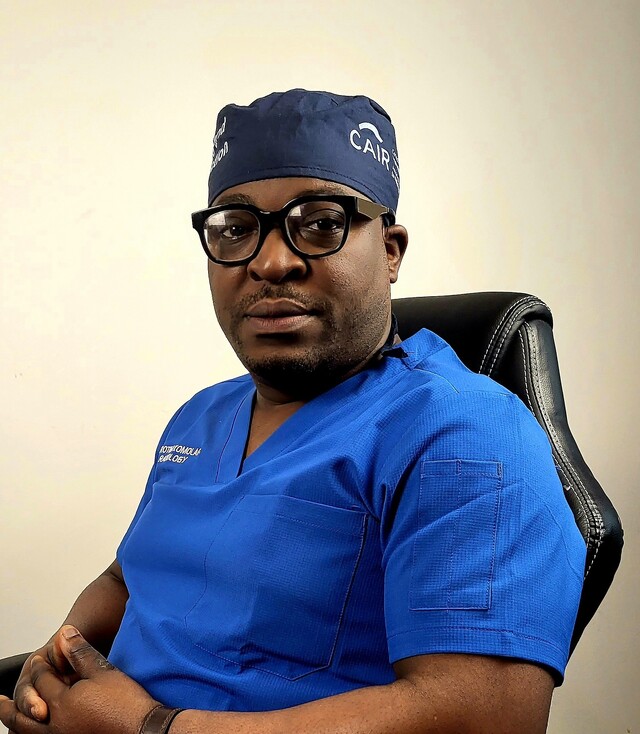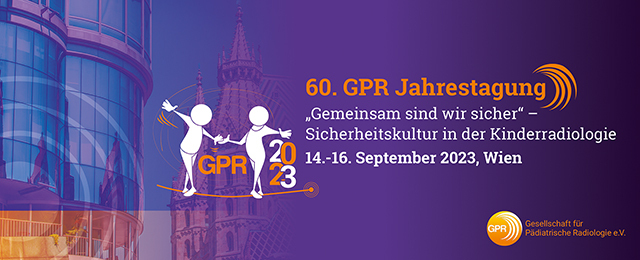 Dr. Rotimi Komolafe The Hospital for SickKids/University of Toronto / Canadaprivate
Dr. Rotimi Komolafe The Hospital for SickKids/University of Toronto / CanadaprivateGPR meets AfSPI - Interview with Dr. Rotimi Komolafe from The Hospital for SickKids/University of Toronto
On the occasion of the 60th annual meeting of the GPR, a special collaboration has been launched. Through the membership of the WSPI ((World Federation of Pediatric Imaging), the Executive Board, together with Dr. Martin Stenzel from Cologne, invited two colleagues from the African Society of Paediatric Imaging (AfSPI) to come to Vienna. DR. OLUROTIMI KOMOLAFE from The Hospital for SickKids/University of Toronto and PROF. OMOLOLA ATALABI from the College of Medicine University of Ibadan /University, Nigeria honor the anniversary annual meeting with their presence. In addition to presentations in the program, the guests will be available for discussion and Q&A sessions and will report on the work in their countries. Below you can read an interview with Dr. Rotimi Komolafe on the occasion of his visit to Vienna.
Mr. Komolafe, you are currently undergoing a 2-year clinical fellowship in pediatric general radiology at Canada's foremost children's hospital - The Hospital for sick Children. What is a typical work day like for you?
A typical work day for me at the Hospital for Sick Children (SickKids for short) actually begins at least the day before. The reason for this is that most patient contact in the hospital is pre-scheduled, so I have to protocol these studies in advance. On the actual work day, my day begins by 8.a.m in whichever unit I am working in for that day. On some days, I have to present at multidisciplinary rounds by 8a.m. – during which the staff radiologist in my unit will provide cover for my absence. Almost every day of the week, there are teaching rounds for residents and fellows. The staff radiologists also provide work cover during these periods. The workflow at the Hospital for Sick Children is pretty efficient, so we are mostly able to attend to all our booked patients, and even accommodate several emergency requests. As can be expected in a tertiary children’s hospital, we have more MRI requests than CT requests. Therefore, my MRI work days are typically the busiest.
You were born in Nigeria and have worked there before. How do you see the situation of pediatric radiology in your home country?
Since beginning subspecialty fellowship training at SickKids, I have been able to better contextualize the situation of pediatric radiology in Nigeria. Sadly, there are so many gaps in physician training, patient management and availability of equipment. These gaps combine to ultimately result in poorer outcomes for Nigeria’s over 95 million children who are aged 15 years or younger. I am really glad that our friends at the GPR are happy to help to reduce some of these gaps.
Would you briefly describe your pediatric radiology CV? How did you get to your current position in Toronto? And what are your plans for the future?
Well, technically I am still at the beginning of creating a formal pediatric radiology CV for myself. However, prior to getting accepted into the fellowship program at SickKids I have served on the website and interventional radiology committees of the Society for Pediatric Radiology. I was also elected as the General Secretary of the Society for Pediatric Imaging in Nigeria. I believe that my passion for pediatric radiology was evident in my fellowship application, and that contributed to my getting accepted into the program. For the future, I am passionate about leveraging the practice of pediatric interventional oncology to combat the menace of metastatic disease in malignant childhood cancers. This would require that I pursue further fellowship training in pediatric interventional radiology and interventional oncology.
Please describe the pediatric radiology department in your current institution. What rooms do you have and what equipment is used?
The Hospital for Sick Children is a well-funded hospital. This has enabled its radiology department to have some of the latest radiological imaging and interventional modalities available. New funding has recently been made available to procure, upgrade and replace some more equipment. Currently, over 3 floors, and in different rooms, there are several digital X-Ray, Fluoroscopy, MRI and CT machines, bi-planar and conventional angiographic suites, SPECT and PET-CT, and a Magnetoencephalography (MEG) machine. The hospital is furnished with several ultrasound machines that have enabled SickKids to become one of the largest paediatric sonography centres in North America. As many as 130,000 examinations are carried out in the radiology department every year.
How would you describe the standing of pediatric radiology in Canada?
From the perspective of a clinical fellow at SickKids, pediatric radiology is practiced at the highest levels in Canada. In fact, one of the things that struck me when I first got here was how the standards of imaging and care for children is exactly as outlined in leading textbooks/journals. Many of the staff radiologists are also super-specialized, having areas of specialty within the broad specialty of pediatric radiology. On a sad note, there does appear to be a diminishing number of Canadian radiology residents applying to general pediatric radiology fellowships. On a positive note, an alumnus of the GPR – Dr. Birgit Ertl-Wagner has recently been appointed as the radiologist-in-chief at SickKids.
How does one become a pediatric radiologist in Nigeria? What are the training steps?
As of now, there are no active training programs to produce pediatric radiologists in Nigeria. The Postgraduate medical colleges in Nigeria are however recently transitioning to a learning system that incorporates a 2-year period of focused training in pediatric radiology, after having completed 3 years of basic sciences and general radiology. Residents who are interested in becoming pediatric radiologists will have to apply to designated, approved centres for the 2-year training.
Why did you become a pediatric radiologist?
I made up my mind to work with children during my pediatrics rotation in medical school. My passion was ignited by the joy and deep sense of fulfillment I got from contributing to the care of sick children, and nursing them back to health. And so, if I was ever going to be a surgeon, I would have been a pediatric surgeon. If I was going to be a physician, I would have been a pediatrician. In the end, I chose to be a radiologist, and made the easy decision to become a pediatric radiologist, in line with my passions.
What are you most looking forward to when you attend the 60th Annual Meeting of the Society of Pediatric Radiology in Vienna in September?
I am looking forward to meeting and thanking all the members of the planning committee in person, as well as getting all the learning I can during the conference at the famed University of Vienna!

